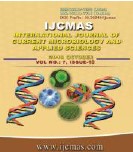


 National Academy of Agricultural Sciences (NAAS)
National Academy of Agricultural Sciences (NAAS)

|
PRINT ISSN : 2319-7692
Online ISSN : 2319-7706 Issues : 12 per year Publisher : Excellent Publishers Email : editorijcmas@gmail.com / submit@ijcmas.com Editor-in-chief: Dr.M.Prakash Index Copernicus ICV 2018: 95.39 NAAS RATING 2020: 5.38 |
Sucking pests have become a serious problem in Bt cotton. The cotton aphid and mealybug reduces its yield to the extent of 30-40 per cent and 40-50 per cent, respectively. In this context an investigation was carried out on synthesis of silica nanoparticles from rice husk and its impact against cotton aphid and mealybug during 2017-18 at centre for nanotechnology lab, UAS Raichur. For comparison purposes, metal silica nanoparticles and dinotefuran 20% SG was used as an insecticide. The biosynthesised nanoparticles were characterized by zetasizer (size: 26.19 nm), UV-visible spectroscopy (wavelength: 310 nm), X-ray diffraction (absorption at 2θ=15-25â° region) and scanning electron microscope (agglomerated form with spherical shape). At five days after treatment green silica nanoparticle at 2000 ppm caused cent per cent mortality of both cotton aphid and mealybug. Pesticidal activity of silica nanoparticles revealed that at 2000 ppm concentration, maximum mortality of insects was recorded and hence can be selectively used for suppression of the pest.
 |
 |
 |
 |
 |